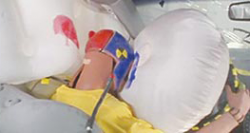
— The latest Insurance Institute for Highway Safety crash test results are in and certain luxury carmakers won’t like the results.
Only three of 11 midsize model year 2012 luxury cars tested earned good or acceptable ratings in a new small overlap frontal crash test.
The safety agency said the test is designed to replicate what happens when the front corner of a car collides with another vehicle or an object like a tree or utility pole.
In the test, 25 percent of a car's front end on the driver side strikes a 5-foot-tall rigid barrier at 40 mph.
Compared to testing by the National Highway Traffic Safety Administration, the Institute's test is considered more strenuous on vehicles.
"Nearly every new car performs well in other frontal crash tests conducted by the Institute and the federal government, but we still see more than 10,000 deaths in frontal crashes each year," Institute President Adrian Lund says.
"Small overlap crashes are a major source of these fatalities. This new test program is based on years of analyzing real-world frontal crashes and then replicating them in our crash test facility to determine how people are being seriously injured and how cars can be designed to protect them better."
The results showed the Acura TL and Volvo S60 earned “good” ratings, while the Infiniti G earned a rating of “acceptable.”
The Acura TSX, BMW 3 series, Lincoln MKZ and Volkswagen CC earned “marginal” ratings.
Following from behind were the Mercedes-Benz C-Class, Lexus IS 250/350, Audi A4 and Lexus ES 350, which earned a rating of “poor.”
Hey dummy, you missed the air bag
The key to protection in any crash is a strong safety cage, then vehicle restraint systems can do their jobs to cushion and protect people.
Most modern cars have safety cages built to withstand head-on collisions and moderate overlap frontal crashes with little deformation.
At the same time, crush zones help manage crash energy to reduce forces on the occupant compartment. The main crush-zone structures are concentrated in the middle 50 percent of the front end.
When a crash involves these structures, the occupant compartment is protected from intrusion, and front airbags and safety belts can effectively restrain and protect occupants.
Luxury and near-luxury cars were first to the test because these models typically get advanced safety features sooner than other vehicles.
The majority of the cars had lots of occupant compartment intrusion, which contributed to their low overall rating.
Occupant motion varied greatly as well, with the dummy missing the airbag in some cases. In others, safety belts allowed the dummy's head and torso to move too far forward.
Forces measured on the dummy indicated high risk of injury for the legs and feet in several vehicles.
Structurally, the Volvo S60 was best, but the Lexus IS had up to 10 times as much occupant compartment intrusion as the Volvo.
In the IIHS test, the car's A-pillar bent and the footwell collapsed as the left front wheel and tire were forced rearward. The dummy's left foot was entrapped by intruding structure, and its right foot was wedged beneath the brake pedal.
Entrapment also was an issue with the Mercedes C-Class. The dummy's right foot ended up wedged beneath the brake pedal as the left front wheel was forced rearward during the crash.
When the Volkswagen CC was put to the test, the driver door was sheared off its hinges, which was a first for the Institute. The Audi A4 had the same problem but at least the door stayed attached to the car.
Every luxury car and near-luxury car the Institute evaluated earned good ratings for head, neck and chest injury risk based on measurements from the dummy's sensors. This is true even though there are many cases of serious upper body injuries in real-world crashes with similar vehicle damage.
Side curtain and torso airbags deployed in the Acura TL and Volvo S60, although the S60's torso airbag fired too late in the crash to protect the dummy's chest from potential contact with side structures.
One or both of the curtain and torso airbags didn't deploy in seven of the cars evaluated. Of the six curtains that deployed, four didn't provide enough forward coverage.
For example, in the Lincoln MKZ test, the dummy's head and chest completely missed the front airbag as the steering column moved to the right.
The side curtain airbag deployed but didn't extend far enough forward to protect the dummy's head.
Another restraint problem engineers flagged was excessive forward movement of the driver dummy caused by too much shoulder belt webbing spooling out of the retractor.
This was the case with the BMW, Mercedes and Volkswagen.
Next on the list will be midsize moderately priced cars, including such top-selling models as the Ford Fusion, Honda Accord and Toyota Camry.




